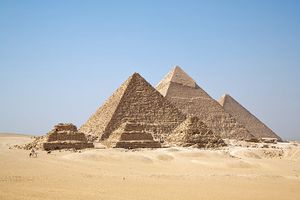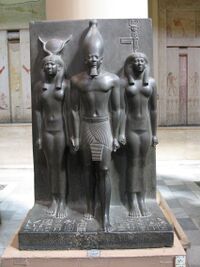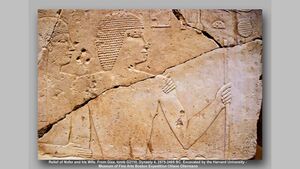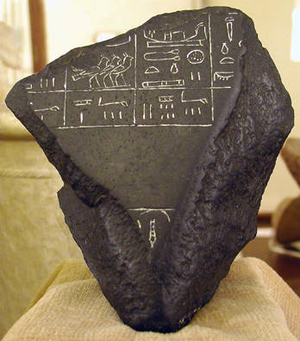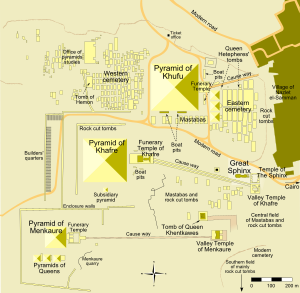الأسرة المصرية الرابعة
| الأسر الفرعونية بمصر القديمة |
| مصر قبل الأسرات |
| عصر نشأة الأسرات |
| عصر الأسر المبكرة |
| 1 - 2 |
| الدولة القديمة |
| 3 - 4 - 5 - 6 |
| الفترة الانتقالية الأولى |
| 7 - 8 - 9 - 10 - |
| 11 (طيبة فقط) |
| الدولة الوسطى |
| 11 (كل مصر) |
| 12 - 13 - 14 |
| الفترة الانتقالية الثانية |
| 15 - 16 - 17 |
| الدولة الحديثة |
| 18 - 19 - 20 |
| الفترة الانتقالية الثالثة |
| 21 - 22 - 23 - 24 - 25 |
| العصر المتأخر |
| 26 - 27 - 28 |
| 29 - 30 - 31 |
| العصر الإغريقي والروماني |
| بطالمة - الإمبراطورية الرومانية |
الأسرة المصرية الرابعة، هي رابع الأسر التي حكمت مصر في الفترة من (2575 ق.م - 2465 ق.م.) ويليها الأسرة المصرية الخامسة و الأسرة المصرية السادسة وهم جميعا يكونوا عصر الدولة القديمة. وكانت عاصمة مصر في ذلك الوقت هي منف.
. . . . . . . . . . . . . . . . . . . . . . . . . . . . . . . . . . . . . . . . . . . . . . . . . . . . . . . . . . . . . . . . . . . . . . . . . . . . . . . . . . . . . . . . . . . . . . . . . . . . . . . . . . . . . . . . . . . . . . . . . . . . . . . . . . . . . . . . . . . . . . . . . . . . . . . . . . . . . . . . . . . . . . . .
أهم الأحداث
يعتبر الملك سنفرو هو مؤسس الأسرة المصرية الرابعة وقد تزوج بالملكة حتب حرس ورزق منها بالملك خوفو ثاني ملوك هذه الأسرة وقد بنى لنفسه مقبرتين متقاربتين على شكل الهرم الكامل ؛ الأولى في دهشور جنوب سقارة والثانية في ميدوم في الشمال في مدخل الفيوم ، وفي عهده قامت حملة بحرية عظيمة إلى الموانئ السورية ورجع منها المصريون بنحو أربعين سفينة محملة بالأخشاب للبناء قد قطعت من غابات لبنان. وكانت مقاطعات مصر 22 مقاطعة من الشلال الأول حتى منف والوجه البحري كان يشمل 20 مقاطعة ، وكان لكل مقاطعة حاكم يعينه الملك يكتب بلقب الأول بعد الملك. ومن الملاحظ أن الملك الذي يتولى الحكم من غير الأسرة المالكة لابد من أن يتزوج بإحدى بنات البيت الملكي.
ولا شك أن الأسرة الرابعة تعد قبل كل شيء "أسرة بناة الأهرام الكبرى"، وأكمل مثال لعصر إلتفت فيه الأمة بأسرها حول الفرعون باعتباره الرمز الأسمى. وفي الواقع لم يكن الفرعون يوجه خبرات البلاد ومواردها لمنفعته فقط وإنما كانت المناصب العليا المدنية منها والدينية تستند كذلك لأفراد عائلته دون سواهم. وهناك عبارة قالها الشاعر "سالي بريدهوم Sully Prudhomme"، مأثورة بسيطة، ولكن لها مايبررها بلا شك، لأننا نواسي بها الشعب المصري وهي : "هذا الشعب كان يطحنه الجرانيت الذي يكدسه خوفو".[1]
ويعكس الفن في ذلك العصر، وبصفة خاصة التماثيل الملكية، مدى الاتقان والروعة الذي بلغته المؤسسة الفرعونية حتى وصل إلى القمة، والذي استمد قواعده من العصر الثيني (العتيق)، وتطور تطورا كبيرا خلال الأسرة الثالثة. بيد أنه في الوقت الذي وصل فيه الفن إلى الذروة، ظهرت بوادر الانهيار للنظام المذهبي للفرعون.
الحكام
| رقم | الفرعون | فترة حكمه |
|---|---|---|
| 1 | سنفرو | 2575 - 2551 ق.م. |
| 2 | خوفو | 2551 – 2528 ق.م. |
| 3 | جدف رع | 2528 - 2520 ق.م. |
| 4 | خفرع | 2520 - 2494 ق.م. |
| 5 | با اف رع | 2494 –2490 ق.م. |
| 6 | منكاورع | 2490 - 2472 ق.م. |
| 7 | شبسس كاف | 2472 – 2467 ق.م. |
| 8 | جدف بتاح | 2467 – 2465 ق.م. |
| أسماء الملوك | اسم حورس (العرش) | التواريخ | الهرم | أسماء الزوجات | |
|---|---|---|---|---|---|
| Sneferu | Nebma'at |  |
2613–2589 BC | Red Pyramid Bent Pyramid Pyramid at Meidum |
Hetepheres I |
| Khufu "Cheops" |
Medjedu |  |
2589–2566 BC | Great Pyramid of Giza | Meritites I Henutsen |
| Djedefre | Kheper |  |
2566–2558 BC ? | Pyramid of Djedefre | Hetepheres II Khentetka |
| Khafre | Userib | 2558–2532 BC | Pyramid of Khafre | Meresankh III Khamerernebty I Hekenuhedjet Persenet | |
| Menkaure | Kakhet |  |
2532–2503 BC ? | Pyramid of Menkaure | Khamerernebty II |
| Shepseskaf | ?? | 
|
2518–2510 BC ? | Pharaoh's Bench at Saqqara | Bunefer |
سنفرو
الملوك الآخرون في عصر الأهرامات
الملك خوفو
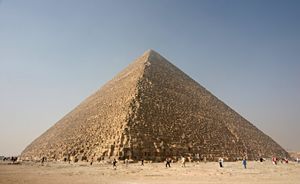
Khufu, known to the Greek as Cheops, and Sneferu's successor—though it is unclear whether he was the biological son of Sneferu—was a widely known king. He is still known very well in present-day media, being featured in movies, novels, and television shows. His fame stems from his pyramid on the northeastern plateau at Giza, where he was buried. His mortuary temple was built on the northern end of the pyramid, which is no longer accessible due to ravages by grave robbers. Only three-dimensional reliefs have been recovered and have lasted into modern day, including many limestone busts and clay figurines. Khufu's activities in and out of Egypt are not well documented (except his architecture work) and was highly romanticized by the Ancient Greeks. These Greeks felt that Khufu was a wicked man who offended the deities and forced his subjects into slavery.[2] But, why was this? Khufu, as the son of Sneferu, was believed to be illegitimate and therefore unworthy of the throne. Even if he was Sneferu's true son, he did very little to expand the country of Egypt and failed to follow his father's footsteps. There are only a few records that stated he was involved in any political activities. The best guess historians can make is that there is evidence of construction of a harbor on the coast of the Red Sea that was excavated by John Gardner Wilkinson and James Burton in 1823.
الملك جدف رع
الملك خفرع
الملك منكاو رع
عصر الأهرامات
The Age of the Pyramids refers to the fact that the Fourth Dynasty was the time when most of the well-known pyramids were built, which include those at Giza. King Sneferu was the first king to express an interest in funerary rites and tombs, which led him to the planning of the largest pyramid at Egypt. His first pyramids were called the Bent Pyramid and Red Pyramid. The "Age of the Pyramids" was not just about the building of large and easily recognizable structures, but also a change in funerary practices and rituals. This includes the burying of elites in large structures and the use of extensive mummification.
. . . . . . . . . . . . . . . . . . . . . . . . . . . . . . . . . . . . . . . . . . . . . . . . . . . . . . . . . . . . . . . . . . . . . . . . . . . . . . . . . . . . . . . . . . . . . . . . . . . . . . . . . . . . . . . . . . . . . . . . . . . . . . . . . . . . . . . . . . . . . . . . . . . . . . . . . . . . . . . . . . . . . . . .
التغيرات الدينية
The Fourth Dynasty is where we truly see a shift in religious practices where worship of the Sun was commonplace. The Cult of Ra grew in size, going back to the fact that Djedef's tomb was built closer to the center of worship in what the Ancient Greeks called Heliopolis.[3] It was a delta city near contemporary Cairo that had been occupied since the predynastic times, whose ancient Egyptian name was I͗wnw or Iunu and meant the pillars.
During the era when centralization of the nation's material, organic, and human resources began to develop, a relationship of the king to the deities became unchallenged and kings began carving their names into statues and monuments that previously had been reserved for deities. This speaks to a type of god complex on part of the kings. Khafre's famous statue, where a falcon was incorporated into his headgear, equated the king to the god Horus.
This fact, however, caused controversy. It was pitting Khafre's allegiance to Horus against the growing Cult of Ra, not far away in Helipolis.[4] Kings no longer associated pyramids with the afterlife. The afterlife was once believed to be a divine kingdom that was represented as a type of idealistic heaven where only kings and pure hearts could go. Instead, the Fourth Dynasty represented a change in this idea, formulated the notion that the afterlife was a familiar place, taking the semblance of Earth.[5] Religious rituals were notoriously conservative, from what historians know, and there is much to be desired from current known records.
تغير العادات أدى إلى تغيرات معمارية
The Old Kingdom saw a rise in the preservation of the deceased, making the preparation of bodies much more complex. The position of embalmer was created, and their jobs were solely to prepare a corpse in private. There were three ways to mummify a body: 1) Stucco: the body would be wrapped in fine linen and then covered in stucco plaster, the features of the body (including the face) were remodeled in the plaster;[6] 2) Linen: the body would be wrapped in linen, which was sometimes treated with natron (a mixture of multiple sodium carbonates[7]) and the linens would be treated with resin so that the features of the body could be modeled; and 3) Defleshing: removing all flesh and wrapping the bones in linens.[8] Generally, organs were removed which were then put into jars that would accompany the body in the tomb, and the inside of the body flushed out.
Tombs in the Fourth Dynasty changed drastically. "Unimpressive" graves did not satisfy the elites, meaning they would settle for smaller structures if the interior was decorated. Hieroglyphic writings were important to elites because, one, it was a lavish display of wealth and, two, it guided their souls to the afterlife. The Fourth Dynasty, however, did not have these writings. Instead, the tomb was deeper and super-structures were larger. After the Giza pyramid complex, later generations of tombs were more reasonably sized. After the Middle Kingdom, royals abandoned pyramids; they preferred graves that were carved into living rock of the Upper Egyptian mountains.
انظر أيضا
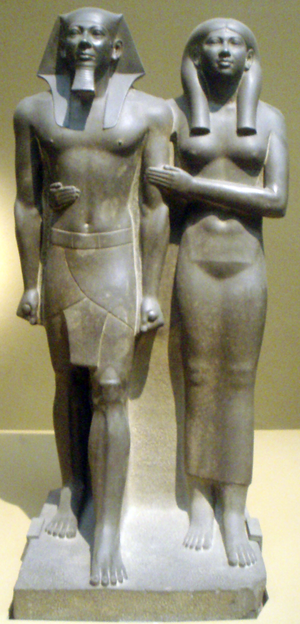
المصادر
- ^ پاسكال ڤيرنوس (1999). موسوعة الفراعنة. دار الفكر.
{{cite book}}: Unknown parameter|coauthors=ignored (|author=suggested) (help) - ^ Tyldesley, Joyce. "Who was Khufu?".
{{cite journal}}: Cite journal requires|journal=(help) - ^ Bolshakov, Andrey O (1991). "The Old Kingdom Representations of Funeral Procession". Göttinger Miszellen (in الإنجليزية). 121: 31–54. Retrieved 14 April 2018.
- ^ Baines, John; Lesko, Leonard H.; Silverman, David P. (1991). Religion in Ancient Egypt: Gods, Myths, and Personal Practice. Cornell University Press. p. 97. ISBN 978-0-8014-9786-5.
- ^ Roth, Ann Macy (1993). "Social Change in the Fourth Dynasty: The Spatial Organization of Pyramids, Tombs, and Cemeteries". Journal of the American Research Center in Egypt. 30: 33–55. doi:10.2307/40000226. JSTOR 40000226.
- ^ "Fragments of stucco from a mummy". Museum of Fine Arts, Boston (in الإنجليزية). 12 March 2018.
- ^ Gill, N.S. (20 August 2018). "Natron, Ancient Egyptian Chemical Salt and Preservative". ThoughtCo.
- ^ "BBC – History – Ancient History in depth: Mummies Around the World".
سليم حسن (1992). موسوعة مصر القديمة. الهيئة العامة للكتاب.

